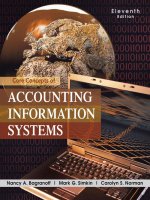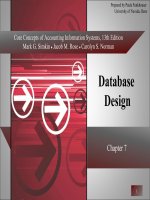Core concepts of accounting information systems 13 by simkin norman chapter 08
Bạn đang xem bản rút gọn của tài liệu. Xem và tải ngay bản đầy đủ của tài liệu tại đây (981.9 KB, 39 trang )
Prepared by Paula Funkhouser
University of Nevada, Reno
Core Concepts of Accounting Information Systems, 13th Edition
Mark G. Simkin ● Jacob M. Rose ● Carolyn S. Norman
Organizing and
Manipulating the
Data in Databases
Chapter 8
1
Chapter 8:
Organizing and Manipulating the Data in Databases
•
•
•
•
Introduction
Creating Database Tables in Microsoft Access
Entering Data in Database Tables
Extracting Data from Databases: Data Manipulation
Languages
• Cloud Databases and Data Warehouses
2
Copyright © 2015. John Wiley & Sons, Inc. All rights reserved.
Creating Database
Tables in Microsoft Access
• Database Management Systems
• An Introduction to Microsoft Access
• Creating Database Tables
• Defining a Record Format
• Creating Relationships
3
Copyright © 2015. John Wiley & Sons, Inc. All rights reserved.
Database Management Systems
• Overview
– Not a database
– Separate software system
• Functions
– Enables users to utilize database information more efficiently
• Examples
– Access, Alpha 5, and Filemaker Pro
4
Copyright © 2015. John Wiley & Sons, Inc. All rights reserved.
Introduction to Microsoft Access
• A popular relational database
• Used by many businesses and individuals
• Used for small database applications
5
Copyright © 2015. John Wiley & Sons, Inc. All rights reserved.
Microsoft Access – Initial Menu
and Opening Screen
6
Copyright © 2015. John Wiley & Sons, Inc. All rights reserved.
Creating Database Tables –
Defining Record Format
• Field Name - Required
– Names assigned to the data fields
• Data Type - Required
– Specified for each data field
• Field properties
– Identifies how to store the data – field properties
• Description - Optional
– Defines record structures
• Identifying a Primary Key
• Saving a Table
7
Copyright © 2015. John Wiley & Sons, Inc. All rights reserved.
Creating Database Tables –
Record Format
8
Copyright © 2015. John Wiley & Sons, Inc. All rights reserved.
Creating Relationships
• Purpose
– Link tables together
– Enable users to create multi-table reports
• Steps in Creating Relationships
– Select tables
– Link the tables
9
Copyright © 2015. John Wiley & Sons, Inc. All rights reserved.
Creating Database Relationships –
Linking Tables
10
Copyright © 2015. John Wiley & Sons, Inc. All rights reserved.
Creating Relationships –
Multitable Relationships
11
Copyright © 2015. John Wiley & Sons, Inc. All rights reserved.
Creating Records
• Records can contain both text and pictures
12
Copyright © 2015. John Wiley & Sons, Inc. All rights reserved.
Creating Records
• Specify names, data types, sizes, descriptions and primary
key
• Dataview Sheet
13
Copyright © 2015. John Wiley & Sons, Inc. All rights reserved.
Ensuring Valid and Accurate Data
Entry
•
•
•
•
•
•
Data Definition Language (DDL)
Proper Data Types for Fields
Input Masks
Default Values
Drop-Down Lists
Referential Integrity
14
Copyright © 2015. John Wiley & Sons, Inc. All rights reserved.
Tools for Data Validation
• Drop-Down Lists
• Validation Rules
– Create rules that limit range of values that may be entered
• Referential Integrity
– Deleting of information disallowed when it would disrupt
references
15
Copyright © 2015. John Wiley & Sons, Inc. All rights reserved.
Drop-Down List Example
16
Copyright © 2015. John Wiley & Sons, Inc. All rights reserved.
Validation Rule Example
17
Copyright © 2015. John Wiley & Sons, Inc. All rights reserved.
Creating Referential Integrity
18
Copyright © 2015. John Wiley & Sons, Inc. All rights reserved.
Study Break #1
All of the following are examples of DBMSs except:
A. Access
B. Oracle
C. DB2
D. SQL
19
Copyright © 2015. John Wiley & Sons, Inc. All rights reserved.
Study Break #2
An example of a validation rule is:
A. An input value must be an integer
B. An input value must also have a default value
C. An input value must be between 0 and 40
D. You cannot delete parent records that have child records
associated with them
20
Copyright © 2015. John Wiley & Sons, Inc. All rights reserved.
Tips for Creating
Database Tables and Records
• Design first
–Create tables and records last
• Name tables systematically
– Use conventional tbl prefixes
• Use mnemonic names for data fields
• Assign correct data types to data fields
21
Copyright © 2015. John Wiley & Sons, Inc. All rights reserved.
Tips for Creating
Database Tables and Records
• Ensure data fields that link tables are the
same data type
• Limit the size of text data fields to reasonable lengths
• Use input masks
22
Copyright © 2015. John Wiley & Sons, Inc. All rights reserved.
Extracting Data From Databases:
Data Manipulation Languages
• Schema
– All information in a database
– All relationships of the tables
– Map of entire database
• Subschema
– Subset of the schema
23
Copyright © 2015. John Wiley & Sons, Inc. All rights reserved.
Creating Select Queries
• Queries
– Create customized subschemas
• Dynaset
– Dynamic subset of a database
– Created by queries
– Data Manipulation Language (DML)
24
Copyright © 2015. John Wiley & Sons, Inc. All rights reserved.
Creating Select Queries
• One-Table Select Queries
– Creates a dynaset
– Based on:
• Criteria determining which records to include
• Criteria determining which fields to include from
those records
– Single or Multiple Criteria
25
Copyright © 2015. John Wiley & Sons, Inc. All rights reserved.









